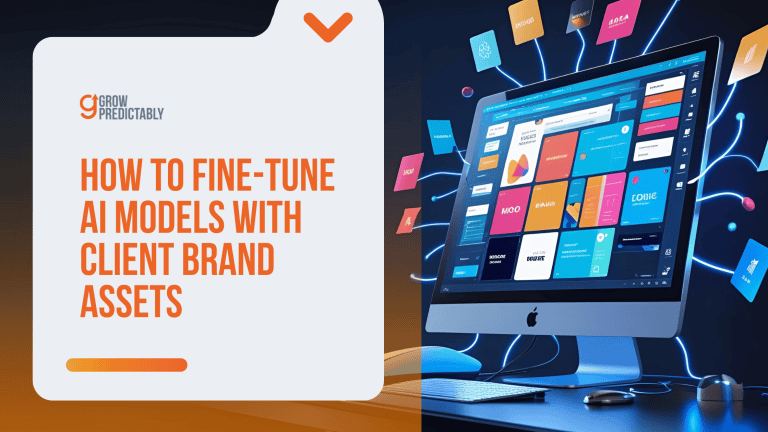Is a Fractional CAIO (Chief AI Officer) Right for Your Business?
AI expertise is expensive, and hiring the wrong leader can slow your company down.
That’s why businesses are turning to fractional chief AI officers—top-ti specialized knowledge AI experts on demand.
They cut costs, boost efficiency, and keep AI projects on track.
But here’s the thing—not every company benefits from this approach.
Is a fractional CAIO your best move or a waste of time? Let’s break it down.
Do You Need a Fractional Chief AI Officer?
A fractional chief AI officer (CAIO) is a part-time executive who helps companies plan and manage their AI projects.
They leverage AI technologies while working with multiple companies, usually spending a few days per month with each one.
Think of them as your AI expert who shows up to help with AI integration when you need them, without the full-time salary.
Responsibilities of a Fractional CAIO
Your fractional chief AI officer handles the big AI decisions.
Decisions like selecting suitable AI technologies and AI tools, minimizing the risks in your organization’s AI strategy, and ensuring AI projects align with your business objectives.
They also train your team and make sure everyone follows the rules about AI ethics, facilitating effective AI implementation and adhering to ethical AI practices.
In recent years, more and more businesses are seeing the great need for experts in this area to help advance business objectives.
According to a Gartner Study, more than 50% of organizations today already have AI leaders within their organization. (Gartner)
This growing trend shows how essential it is today for experts who can consult, inform, and lead AI advancements to be present in key business objectives.
Differences from Regular CAIOs
Here’s what makes them different from regular CAIOs:
| Fractional CAIO | Full-time CAIO |
|---|---|
| Works 2-8 days per month | Works full-time |
| Costs $5,000-15,000 monthly | Costs $180,000-350,000 yearly |
| Brings experience from multiple companies | Focuses on one company |
| More flexible contract terms | Long-term commitment |
| Best for small/medium businesses | Better for large enterprises |
Main Areas of Focus
The role covers these main areas:
- Implementing cutting-edge AI technologies and setting up your AI business strategy
- Picking the right AI technologies and vendors
- Training your team on AI
- Making sure AI projects stay within budget
- Standardizing AI ethics
Small companies often pick Fractional CAIOs because they get high-level AI expertise and support in AI implementation without spending too much.
You might only need them for specific projects or to get your AI program started.
Once things are running smoothly, you can decide if you want to keep working together or bring someone on full-time—a decision that must always be influenced by your greater business objectives.
Remember, a Fractional CAIO isn’t just a consultant – they’re part of your leadership team while they work with you.
They join your meetings, help make big decisions, and work closely with other executives to make AI work for your business.
Benefits of Hiring a Fractional CAIO
Engaging a Fractional Chief AI Officer (CAIO) can bring value to your business in several ways.
Let’s break it down into three main advantages: cost savings, flexibility, and high-level expertise.
1. Cost Savings
Hiring a full-time CAIO can be expensive. According to industry reports, CAIO salaries can range upwards of $250,000 per year.
By opting for a fractional CAIO, you pay only for the time and expertise you need, making it a budget-friendly choice.
This approach allows you to access top-tier AI leadership without the full-time commitment.
2. Flexibility
With a fractional chief AI officer, you get the flexibility to scale their involvement based on your project needs.
They can step in during crucial phases of AI implementation or when strategic decisions are required.
This model supports businesses that are either in the early stages of their AI journey or those that need intermittent high-level AI insights during their process of AI adoption.
3. High-Level Expertise
Fractional CAIOs bring a wealth of experience in risk management and specialized knowledge, helping to accelerate AI implementation.
They provide external leadership insights and offer risk mitigation by identifying potential pitfalls commonly linked AI integration.
Companies have reported up to 30% faster project roll-outs with expert guidance.
This expertise, combined with robust risk management and effective AI implementation, ensures that your organization remains competitive in a rapidly evolving tech landscape.
4. ROI Considerations
The tangible benefits of hiring a fractional CAIO, including strategic guidance, extend beyond just cost savings.
They enhance internal team capabilities through knowledge transfer, equipping your staff with skills and insights from industry leaders, and ensure ethical AI practices in all implementations.
This not only boosts confidence but also fosters a culture of continuous learning.
Additionally, by offering strategic guidance, ensuring successful AI implementation, and reducing the risks associated with AI deployment, you safeguard your investments and improve overall ROI.
By choosing a fractional CAIO, your business can enjoy expert AI leadership and strategic guidance tailored to your unique needs, all while keeping costs and commitments in check.
To find AI experts on LinkedIn, you can use the search bar with relevant keywords like “artificial intelligence,” “AI tools,” “machine learning,” “deep learning,” “data scientist,” or specific AI applications, filter by job titles like “AI Engineer” or “Machine Learning Scientist,” and leverage LinkedIn’s AI-assisted search feature to identify profiles with the most relevant experience and skills.
Who Should Consider (or Avoid) Hiring a Fractional CAIO?
Deciding if a fractional Chief AI Officer (CAIO) is right for your business involves careful consideration.
Here’s a structured guide to help you decide:
Company Size:
- Small to Mid-Sized: Often benefit from expert guidance in AI adoption without the burden of full-time salaries.
- Large Corporations: May benefit during specific projects or transformations.
AI Maturity Level:
- Early Phase: If your AI journey has just begun, external expertise can accelerate progress.
- Developed AI Program: You might only need a fractional chief AI officer for strategic pivots or advice.
Budget:
- Limited Budget: A fractional CAIO offers expert insights at a fraction of the cost.
- Flexible Budget: Consider your need for sustained AI leadership versus short-term guidance.
When to Avoid Hiring a Fractional CAIO
Now, we need to remember that working with a fractional CAIO is a venture that needs time and proper planning.
And just like with any venture, sometimes it doesn’t work.
Here are business scenarios where it may not be necessary to work with a fractional CAIO:
- Strong Internal AI Leadership: If you already have a capable AI team and leadership, duplicating roles might be unnecessary.
- Non-Tech-Focused Businesses: Companies with no immediate plans or strategies for AI might not see substantial benefits.
- Small-Scale Operations with Single AI Tasks: A specialized consultant may suffice if AI needs are minimal.
Industry-Specific Use Cases
Deploying AI technologies with a fractional chief AI officer can create different possibilities for different types of businesses across industries.
Here is a brief look at what fractional AI expertise can mean for you.
Healthcare
A CAIO can assist with patient data management and personalized treatments.
Fintech
Beneficial for improving fraud detection systems and customer service automation.
E-commerce
Useful for personalizing customer experiences and optimizing supply chains.
Manufacturing
Enhances predictive maintenance and production efficiency.
Every business has unique needs. While a fractional CAIO can develop customized AI roadmaps and provide significant strategic and cost-saving advantages, understanding your company’s specifics will ensure the best fit.
You should at all times consider how this decision aligns with your overall business strategy and long-term goals.
Checklist: Is it time to work with a fractional CAIO?
Aside from the tips above keep this checklist on hand, or customize your own version, to help you assess whether or not your business really needs the support of a fractional CAIO.
Go over these questions one by one; as you do, think about your current preparedness as transparently as you can.
✔️ or ❌ Is your company looking to integrate AI into its business strategy?
✔️ or ❌ Do you currently lack internal leadership with strong AI expertise?
✔️ or ❌ Are you in the early stages of adopting AI technologies?
✔️ or ❌ Do you need strategic guidance for specific AI projects or transformations?
✔️ or ❌ Is your business on a limited budget, making a full-time AI officer impractical?
✔️ or ❌ Does your company require intermittent AI insights rather than continuous guidance?
✔️ or ❌ Are there gaps in your current AI skills or technology that need expert attention?
✔️ or ❌ Does your industry have specific AI use cases that you wish to explore?
✔️ or ❌ Does your existing AI program lack a comprehensive AI strategy and is well-developed but in need of strategic adjustments or pivots?
✔️ or ❌ Are you looking for ways to fast-track AI implementation without a permanent hire?
Answering these questions can quickly help you determine whether or not engaging a fractional CAIO aligns with your company’s greater business objectives.
Getting more ‘✔️‘ means you’re probably at a point where a fractional CAIO’s support is needed; getting the opposite (❌) is a sign that it might not be the most necessary step yet in your current situation.
Practical Guide to Hiring a Fractional CAIO

Ready to bring in a Fractional Chief AI Officer (CAIO)?
If you are, there are factors that you need to assess that will guide you to finding the ideal fractional CAIO for your AI needs.
Before deciding on one, think about the following:
- What are your AI needs?
- How will a comprehensive AI strategy be developed, and what responsibilities will your CAIO hold?
- What expectations do you have from your CAIO?
- Where do you plan to find the best candidates?
- How will you gauge the candidate’s suitability to your hiring objectives?
- What will you stipulate in the contracts?
- How will you introduce this chosen candidate to your teams?
Here’s your step-by-step guide to making all of this happen smoothly and effectively:
Step 1: Assess AI Needs
You can’t begin the process of scouting for a fractional CAIO if you’re not clear about the AI adoption needs within your ecosystem.
This step will make it easier for your future fractional CAIO to bring out the results that your business needs.
- Identify Business Objectives: Establish a comprehensive AI strategy aligned with business objectives. This helps tailor the CAIO role to your specific needs.
- Evaluate Current Capabilities: Look at your current AI resources and identify where expertise is lacking. This clarity will focus the CAIO’s efforts where they’re needed most.
Step 2: Define Role Scope
Determining what your fractional CAIO will and won’t do is crucial for a successful partnership.
By defining the role scope, your fractional CAIO will know exactly where to focus efforts for maximum impact.
- Outline Responsibilities: Clearly define what you expect from the CAIO. Will they lead AI strategy, manage specific projects, or both?
- Determine Engagement Type: Decide whether you need a short-term engagement for a specific phase or ongoing support for evolving needs.
Step 3: Set Hiring Objectives
Before seeking candidates, it’s important to know exactly what you are looking for.
Identifying essential qualities helps streamline the selection process and ensures alignment with your business strategy.
Essential Qualities to Look For:
- Strategic Vision: Seek candidates who understand market trends and can align AI efforts with your business strategy.
- Technical Acumen: Ensure they have deep knowledge of AI technologies and their practical applications.
- Business Alignment: The CAIO should bridge AI initiatives with your company’s goals for cohesive operation.
Step 4: Find Candidates
The search for the right fractional CAIO involves reaching out to the right places.
By leveraging professional networks to integrate AI successfully and considering the right agencies, you can find a candidate who fits the specialized role.
- Leverage Networks: Use professional networks, AI forums, and industry events to discover potential candidates.
- Consider Agencies: Engage with specialist recruitment agencies that focus on technology leadership roles.
Step 5: Conduct Interviews
Interviews are key to understanding if a candidate truly fits your needs, particularly how they will handle AI integration.
Asking focused questions gives insight into how they operate and think. This step helps you assess their ability to integrate AI strategies with your company’s vision.
Suggested Questions:
- How do you ensure AI strategies align with our company’s goals?
- Can you share a successful AI initiative you led, and what was the outcome?
- What do you see as the biggest challenges in AI implementation, and how do you address them?
Step 6: Structure Engagement Contracts
Creating a detailed engagement contract sets the groundwork for a successful working relationship.
Defining scope and performance metrics protects both parties and clarifies expectations.
- Define Scope and Duration: Be explicit about what the CAIO will do and for how long.
- Set Performance Metrics: Specify what success looks like to evaluate the CAIO’s impact effectively.
Step 7: Onboard and Integrate
Bringing your fractional CAIO on board requires a structured approach for seamless integration.
Proper onboarding helps them understand your company quickly and start making an impact.
By ensuring they’re well-connected and resourced from day one, you set them up for success.
Onboarding Checklist:
- Introduce to Key Stakeholders: Facilitate meetings with important team members to encourage collaboration.
- Set Clear Expectations: Align roles, goals, and expected outcomes early on.
- Provide Resources: Ensure they have the tools and support to be effective from day one.
By following this structured approach, hiring a fractional CAIO becomes a smooth process.
This guide ensures that your new AI leader is set up for success, helping drive your business’s AI capabilities to new heights.
Case Study: RTB AI’s Custom Solutions for Nursing Facilities

AI experts who facilitate AI adoption, develop a comprehensive AI strategy, and often work with multiple businesses, like Ilan Buckman of RTB AI, play a pivotal role in helping businesses achieve critical milestones with AI systems.
Such experts provide multi-industry insights, flexibility, and bespoke solutions tailored to unique business challenges despite the unconventional partnership structures often involved.
In this case study, we’ll take a quick look at how Ilan of RTB AI provided the above AI solutions to nursing facilities.
The case study involves hospitals, which refer patients to SNFs, and the skilled nursing facilities themselves, which are tasked with assessing and admitting patients efficiently.
RTB AI provides technological solutions to enhance this multifaceted decision-making process.
Challenge
In the process of discharging patients from hospitals to skilled nursing facilities (SNFs), hospitals face the daunting task of swiftly finding suitable placements while SNFs must quickly assess incoming referrals.
This process involves reviewing extensive patient files to ensure care needs align with the facility’s offerings, all under Medicare’s flat-rate reimbursement constraints.
The complexity of making rapid, informed admissions decisions without incurring financial losses poses significant challenges for SNFs.
Solution
RTB AI developed an admissions co-pilot tool designed to optimize decision-making in SNFs.

This tool, supported by RAG-based AI technology, extracts critical information from patient files uploaded to a secure portal.
It identifies potential yellow and red flags, assesses cost implications, and reviews the patient’s condition relevant to facility capabilities.

Additionally, an admin portal allows leadership to continually adjust decision criteria.
This solution automates the entry of information into a CRM system and generates summary cover sheets, streamlining the admissions process.
Results
The implementation of this AI-powered admissions co-pilot tool brought significant enhancements to SNF operations:
- Increased Efficiency: SNFs could respond more swiftly to hospital referrals, leading to optimized occupancy rates.
- Improved Visibility: Enhanced organizational insight into referral decisions, providing clarity on the basis for admissions or denials.
- Cross-Coverage Capabilities: Enabled team members to manage admissions seamlessly in the absence of key staff, as showcased when a team member successfully admitted a new patient while the admissions director was out of the office.
- Sustained Operations: Facilitated continuous admissions operations without interruption, enhancing resilience and flexibility.
- Potential for Future Growth: Positioned for further evolution to potentially offer personalized admission recommendations, thereby advancing operational efficiency, decision-making quality, and patient care coordination within skilled nursing facilities.
This progression marks a substantial enhancement in operational efficiency, decision-making quality, and patient care coordination for SNFs, with the potential for further development to offer admission recommendations.
This case illustrates the transformative potential of AI solutions in improving business operations and achieving strategic goals within the healthcare sector.
Addressing Challenges and Limitations
Effectively working to integrate AI with a Fractional CAIO comes with its share of speed bumps.
You’ll want to know about them before jumping in.
Time Zones and Scheduling
Time zones and schedules often cause headaches when your CAIO works with multiple companies.
Your urgent needs might clash with other commitments they have.
Communication Gaps
Communication gaps can pop up since your CAIO isn’t in the office daily.
Your team might feel disconnected or miss important updates if there’s no good system in place.
Common Issues
Here are the most common issues companies face:
- Slower decision-making because the CAIO isn’t always available.
- Knowledge transfer problems occur when the CAIO works with multiple teams.
- Cultural fit challenges since they’re not fully embedded in your company.
- Project delays due to limited availability.
- Budget overruns if the scope isn’t clearly defined.
Solutions
To tackle these challenges effectively, establish weekly check-ins and leverage collaborative project management tools to keep everyone informed and engaged.
At the outset, clearly outline goals and deadlines, ensuring all parties agree. This prevents misunderstandings and keeps the team aligned.
Regular communication and transparent expectations will bridge gaps and foster a sense of connection, even when the fractional CAIO isn’t physically present.
Ultimately, this helps ensure seamless AI integration, mitigating delays and budget overruns while enhancing overall project execution.
Make sure your contract spells out exactly what you need:
- Hours per week or month
- Response times for urgent issues
- Main projects and responsibilities
- Communication expectations
- How success will be measured
Some companies use a buddy system – pairing the Fractional CAIO with an internal leader who can handle day-to-day questions. This keeps things moving when the CAIO is working elsewhere.
Knowledge Sharing
Remember to plan for knowledge sharing.
Ask your CAIO to document their work and train your team along the way.
This builds your internal AI skills over time.
The key is spotting these challenges early and tackling them head-on.
FAQs
The Future of AI Leadership is Flexible
A Fractional CAIO offers companies a flexible, cost-effective solution to AI leadership, making cutting-edge AI expertise accessible to businesses of all sizes.
From selecting AI tools to ensuring legal compliance and team training, their impact can be transformative.
The business landscape is evolving faster than ever, and AI is at the center of this transformation. Adapting quickly while managing costs efficiently can set your company on a path to long-term success.
A Fractional CAIO makes this transition smoother and more strategic.
If you’re curious about whether this model can work for you, start by consulting with AI professionals, researching companies that have done it successfully, and mapping out your AI goals.
Could a Fractional CAIO be the missing piece in your business strategy?
Let us know your biggest AI challenges in the comments!








